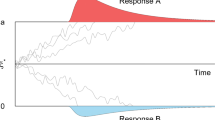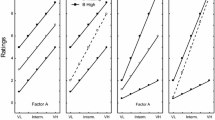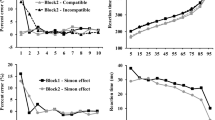Abstract
Takane and Sergent developed a model (MAXRT) for scaling same/different judgments and response times (RTs) simultaneously. The model assumes that RTs are distributed lognormally. Our experiment showed that the RT distribution of the judgments might be task dependent. It is shown that lognormal RTs provide a far better fit than exponential, normal, and Pareto distributed RTs (with the same means and variances), but that the final parameter estimates from the data set with lognormal RTs hardly differ from the alternatively distributed RTs. Finally, despite the robustness of the distributional assumption of the RTs with respect to the parameter estimates, it is shown that RTs have an informational value that is not contained in the same/different judgments alone.
Similar content being viewed by others
References
Akaike, H. (1974). A new look at the statistical model identification.IEEE Transactions on Automatic Control, 19, 716–723.
Anderson, J. R., & Bower, G. H. (1973).Human associative memory. Washington: Winston & Sons.
Behrman, B. W., & Brown, D. R. (1968). Multidimensional scaling of form: A psychophysical analysis.Perception & Psychophysics, 4, 19–25.
Brown, D. R., & Andrews, M. H. (1968). Visual form discrimination: Multidimensional analysis.Perception & Psychophysics, 3, 401–406.
Chocholle, R. (1940). Variations des temps de réaction auditifs en fonction de l'intensité à diverses fréquences [Variations of auditory reaction times as a function of intensity at varying frequences].L'Année Psychologique, 41, 65–124.
D'Agostino, R., & Stephens, M. A. (1986).Goodness-of-fit techniques. New-York: Dekker.
De Soete, G. (1986). A perceptual study of the Flury-Riedwyl faces for graphically displaying multivariate data.International Journal for Man-Machine Studies, 25, 549–555.
De Soete, G., & Carroll, J. D. (1983). A maximum likelihood method for fitting the wandering vector model.Psychometrika, 48, 553–566.
Flury, B., & Riedwyl, H. (1981). Graphical representation of multivariate data by means of asymmetrical faces.Journal of the American Statistical Association, 76, 757–765.
Flury, B., & Riedwyl, H. (1983).Some applications of asymmetrical faces. Unpublished manuscript, Institut für Mathematische Statistik und Versicherungslehre, Universitaet Bern.
Green, D. M., & Luce, R. D. (1967). Detection of auditory signals presented at random times.Perception & Psychophysics, 2, 441–449.
Green, D. M., & Luce, R. D. (1971). Detection of auditory signals presented at random times III.Perception & Psychophysics, 9, 257–268.
Harrington, L. F., & Brown, D. R. (1972). Visual pattern perception: Multidimensional analysis of discrimination difficulty for children.Psychonomic Science, 29, 219–221.
Ida, M. (1980). The application of the Weibull distribution to the analysis of the reaction time data.Japanese Psychological Review, 22, 207–212.
Johnson, N. L., & Kotz, S. (1970).Distributions in statistics: Continuous univariate distributions-2. Boston: Houghton Miffin.
Kak, A. V., & Brown, D. R. (1979). Visual pattern perception: Multidimensional analysis of development of children's reading skills.Perceptual and Motor Skills, 49, 819–830.
Kirk, R. E. (1982).Experimental design. Procedures for the behavioral sciences (2nd ed.). Belmont, CA: Brooks/Cole.
Kohfeld, D. L., Santee, J. L., & Wallace, N. D. (1981). Loudness and reaction time: II. Identification of detection components at different intensities and frequencies.Perception & Psychophysics, 2, 550–562.
Kruskal, J. B. (1964a). Multidimensional scaling by optimizing goodness of fit to a nonmetric hypothesis.Psychometrika, 29, 1–27.
Kruskal, J. B. (1964b). Multidimensional scaling: A numerical method.Psychometrika, 29, 115–129.
Luce, R. D. (1986).Response times. Their role in inferring elementary mental organization. New York: Oxford University Press.
Luce, R. D., & Green, D. M. (1970). Detection of auditory signals presented at random times II.Perception & Psychophysics, 7, 1–14.
McGill, W. J., & Gibbon, J. (1965). The general gamma distribution and reaction times.Journal of Mathematical Psychology, 2, 1–18.
Medin, D. L., & Schaffer, M. M. (1978). Context theory of classification learning.Psychological Review, 85, 207–238.
Melara, R. D. (1989). Similarity relations among synesthetic stimuli and their attributes.Journal of Experimental Psychology: Human Perception and Performance, 15, 212–231.
Murdock, B. B. (1985). An analysis of the strength-latency relationship.Memory and Cognition, 13, 511–521.
Pearson, E. S., D'Agostino, R. B., & Bowman, K. O. (1977). Tests for departure from normality: Comparison of powers.Biometrika, 64, 231–246.
Podgorny, P., & Garner, W. R. (1979). Reaction time as a measure of inter and intra-object visual similarity.Perception & Psychophysics, 26, 37–52.
Ratcliff, R. (1978). Theory of memory retrieval.Psychological Review, 85, 59–108.
Ratcliff, R., & Murdock, B. B. (1976). Retrieval processes in recognition memory.Psychological Review, 86, 190–214.
Royston, J. P. (1982). An extension of Shapiro and Wilk'sW test for normality to large samples.Applied Statistics, 31, 115–124.
Scheiblechner, H. (1979). Specifically objective stochastic latency mechanisms.Journal of Mathematical Psychology, 19, 18–38.
Sergent, J., & Takane, Y. (1987). Structures in two-choice reaction-time data.Journal of Experimental Psychology: Human Perception and Performance, 13, 300–315.
Shapiro, S. S., & Wilk, M. B. (1965). An analysis of variance test for normality (complete samples).Biometrika, 52, 591–611.
Shrout, P. E., & Fleiss, J. L. (1979). Intraclass correlations: uses in assessing rater reliability.Psychological Bulletin, 86, 420–428.
Snodgrass, J. G., Luce, R. D., & Galanter, E. (1967). Some experiments on simple and choice reaction times.Journal of Experimental Psychology, 75, 1–17.
Takane, Y., & Sergent, J. (1983). Multidimensional scaling models for reaction times and same-different judgments.Psychometrika, 48, 393–423.
Townsend, J. T., & Ashby, F. G. (1983).The stochastic modeling of elementary psychological processes. Cambridge: University Press.
Tversky, A. (1977). Features of similarity.Psychological Review, 84, 327–352.
Young, F. W. (1970). Nonmetric scaling for line length using latencies, similarity, and same-different judgments.Perception & Psychophysics, 8, 363–369.
Author information
Authors and Affiliations
Additional information
The authors thank Jan Beirlant, Geert De Soete, Yoshio Takane, the three reviewers, and the Editor, for their useful comments on earlier versions of this manuscript. We are also indebted to Noël Bovens for his help in programming the experiments.
Rights and permissions
About this article
Cite this article
Storms, G., Delbeke, L. The irrelevance of distributional assumptions on reaction times in multidimensional scaling of same/different judgment tasks. Psychometrika 57, 599–614 (1992). https://doi.org/10.1007/BF02294422
Received:
Revised:
Issue Date:
DOI: https://doi.org/10.1007/BF02294422




